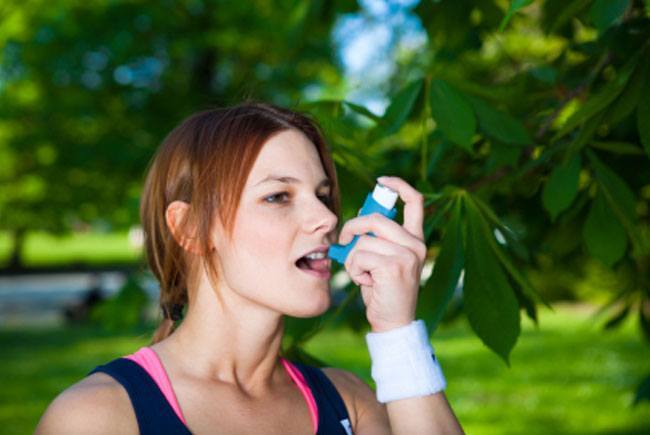
Exercise is one of the most vital routine our life. When it comes to staying fit and healthy in the long run, we just can’t ignore its importance. But like all other good things, exercise also comes with its own loopholes. The physical exertion associated with workout may trigger certain health conditions, and asthma is the most common one among them.
There is a misconception that a person should stop exercising as soon as he or she starts experiencing symptoms of asthma. As per people, it will prevent the condition from getting worse. Well, how much true is it?
Let us go for a reality check.
[Also Read: How To Fit Into Size Zero Jeans]
Find below everything you need to know about exercise-induced asthma and its management.

source:wasatchallergy.com
What Is Exercise-Induced Asthma (EIA)?
Exercise-Induced Asthma (EIA) is a term used commonly for Exercise-Induced Bronchoconstriction (EIB). As the name suggests, it is a condition of constriction of our bronchial passage, which is caused by prolonged exercise. No matter whether you already have chronic asthma or not, you may experience its symptoms while working out vigorously. Though EIA symptoms do not necessarily mean that the person has asthma, it has been found that almost 90% people with asthma suffer from EIA.
How Does Exercise Induce / Affect Asthma?
Usually, we breathe slowly through the nose when not exercising. It makes the external air a little warm and moist during its travel to the lungs through the nasal passage. But the scenario changes a lot during workout as we keep breathing fast through the mouth. It does not allow the external air to get warmed-up and moistened. So, we end up inhaling comparatively colder and drier air this time.
This loss of heat as well as moisture from the air makes the muscle bands around the nose and the upper airways quite sensitive. So, they contract to respond to this temperature and humidity alterations, which narrows the bronchial passage and eventually hampers the airflow. As a result, we start experiencing the symptoms of EIA.
Factors that Trigger Exercise-Induced Asthma
EIA can affect anyone irrespective of age and gender. However, knowing the factors that can trigger it will help you fight against the issue successfully. We have listed them down:
- Hyperventilation
- Airborne respiratory irritants
- Prolonged exercise
- Intense physical activity
- Workout in cold, dry air
Symptoms of Exercise-Induced Asthma
If your heart beats harder and faster during exercise, do not worry about EIA as it is absolutely normal. But if you face any of the following issues within 5 to 20 minutes of starting your workout session or 10 to 15 minutes after finishing it, you may have developed EIA. Check out the symptoms below:
- Wheezing
- Gasping
- Coughing
- Chest tightening
- Trouble speaking
- Extreme fatigue
- Reduced stamina
- Sore throat
- Indigestion
- Cyanosis
Also Read How to get rid of Cold Sores at Home.
How to Diagnose Exercise-Induced Asthma
You should seek help of a professional (allergist) to determine whether the asthma attack symptoms you are experiencing are induced by exercise or not. You will be asked for the following information:
[sc:mediad]
- Family history (to check previous occurrences of asthma or breathlessness)
- Work out details (duration and intensity)
- Place of exercise
- Details of other physical activities
You may also have to go through a few respiratory tests depending upon the information provided.

source:drkripsak.com
How to Manage and Treat Exercise-Induced Asthma
Avoiding exercise or strenuous physical activities is not at all a viable solution for EIA. Rather, you can manage it efficiently or treat it completely by following some proven methods. Check them out here:
- Use bronchodilator or asthma inhaler 30 to 60 minutes before starting your workout session.
- Take beta-2 agonist asthma medications (short or long-acting based on your requirements) at least 10 minutes prior to exercising.
- Inhale anti-inflammatory cromolyn sodium medications (Tilade, Intal, etc.) minimum 15 to 20 minutes before workout.
- Make sure that you warm up before starting your regular exercise routine and cool down once you are done with it.
- Try to stay away from EIA-triggering factors as much as possible.
- Do not over-exercise. Rather, increase the time and level of intensity gradually so that your body gets used to it.
- In case it is cold or highly polluted outside, put on a mask during workout or simply exercise indoor.
- Though it sounds a bit difficult, make an effort to breathe through your nose while exercising.
Exercise could certainly affect your asthma, but it should never be an excuse to avoid physical activities. In fact, the overall health and well-being of an asthma patient will improve considerably if he or she continues working out. Just keep in touch with an expert and take preventive measures and there will be nothing to worry.
